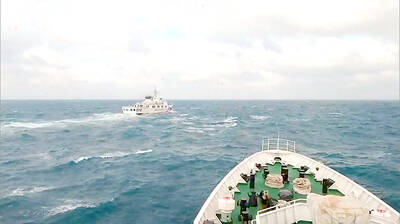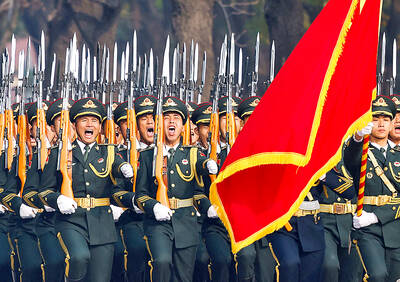Salvage crews found bodies and a wing section from an Air France jet that plunged into the Atlantic as investigators yesterday probed a possible link between false speed measurements and the crash.
Six days after Air France flight 447 from Rio de Janeiro to Paris disappeared while flying through violent storms in the middle of the night with 228 passengers and crew on board, speculation is focusing on its airspeed monitors.
Brazilian naval and air force crews found two bodies on Saturday and were continuing to come across wreckage, including part of the twin-engined Airbus A330’s wing as well as floating luggage, yesterday.
“As well as the bodies there are various remains of the aircraft. Plane seats, part of the wing and various other items were localized,” air force spokesman Lieutenant Colonel Henry Munhoz told reporters in Recife.
The doomed jet broadcast a series of 24 automatic error messages as its systems shut down one-by-one in its final minutes, and French accident investigators say the cockpit was receiving conflicting speed data.
Following the crash, Airbus warned pilots to review their methods to cope with this problem and Air France said on Saturday that it had accelerated existing plans to replace the monitoring units in its jets.
The device in question is the pitot probe, usually on the leading edge of a wing, which measures the force of the air through which an aircraft passes.
French Transport Minister Dominique Bussereau said it was too early for investigators to say what was the most likely cause of the crash, but confirmed that Airbus jets had experienced problems with speed monitors.
“There have been situations on Airbus planes, and perhaps on others, where these probes ice up in a very wet area, a deep depression, an area of storms, and no longer give the correct speed reading,” Bussereau told RTL radio.
“It’s obvious that if the pilots in the cockpit no longer have the correct speed in front [of them] that can lead to two bad consequences for the survival of the plane,” he said. “Too low a speed, which can cause it to stall, or too high a speed, which can lead to the plane ripping up as it approached the speed of sound, as the outer skin is not designed to resist such speed.”
A French nuclear submarine has been dispatched to the zone to help in the search, a race against time to find the black box flight data recorders in deep waters before they stop emitting a locator signal in a month’s time.
Other evidence found in the seas is being brought to the Fernando de Noronha archipelago, the closest inhabited spot to the zone where they were found, for initial inspection by forensic police.
From there, they were to be flown to Recife for further analysis by French officials. Two male bodies the Brazilian navy recovered in the zone will also flown to Recife, Munhoz said.
A blue plane seat, a nylon backpack containing a computer and vaccination card, and a leather briefcase with an Air France ticket inside were the first objects plucked from the sea, officials said.
The discoveries took place 450km northeast of the Fernando de Noronha islands, which are 370km from the mainland. The precise spot was 70km northeast of the point of last communication with the plane.

The Ministry of Foreign Affairs (MOFA) yesterday said it is closely monitoring developments in Venezuela, and would continue to cooperate with democratic allies and work together for regional and global security, stability, and prosperity. The remarks came after the US on Saturday launched a series of airstrikes in Venezuela and kidnapped Venezuelan President Nicolas Maduro, who was later flown to New York along with his wife. The pair face US charges related to drug trafficking and alleged cooperation with gangs designated as terrorist organizations. Maduro has denied the allegations. The ministry said that it is closely monitoring the political and economic situation

UNRELENTING: China attempted cyberattacks on Taiwan’s critical infrastructure 2.63 million times per day last year, up from 1.23 million in 2023, the NSB said China’s cyberarmy has long engaged in cyberattacks against Taiwan’s critical infrastructure, employing diverse and evolving tactics, the National Security Bureau (NSB) said yesterday, adding that cyberattacks on critical energy infrastructure last year increased 10-fold compared with the previous year. The NSB yesterday released a report titled Analysis on China’s Cyber Threats to Taiwan’s Critical Infrastructure in 2025, outlining the number of cyberattacks, major tactics and hacker groups. Taiwan’s national intelligence community identified a large number of cybersecurity incidents last year, the bureau said in a statement. China’s cyberarmy last year launched an average of 2.63 million intrusion attempts per day targeting Taiwan’s critical

‘SLICING METHOD’: In the event of a blockade, the China Coast Guard would intercept Taiwanese ships while its navy would seek to deter foreign intervention China’s military drills around Taiwan this week signaled potential strategies to cut the nation off from energy supplies and foreign military assistance, a US think tank report said. The Chinese People’s Liberation Army (PLA) conducted what it called “Justice Mission 2025” exercises from Monday to Tuesday in five maritime zones and airspace around Taiwan, calling them a warning to “Taiwanese independence” forces. In a report released on Wednesday, the Institute for the Study of War said the exercises effectively simulated blocking shipping routes to major port cities, including Kaohsiung, Keelung and Hualien. Taiwan would be highly vulnerable under such a blockade, because it

Conflict with Taiwan could leave China with “massive economic disruption, catastrophic military losses, significant social unrest, and devastating sanctions,” a US think tank said in a report released on Monday. The German Marshall Fund released a report titled If China Attacks Taiwan: The Consequences for China of “Minor Conflict” and “Major War” Scenarios. The report details the “massive” economic, military, social and international costs to China in the event of a minor conflict or major war with Taiwan, estimating that the Chinese People’s Liberation Army (PLA) could sustain losses of more than half of its active-duty ground forces, including 100,000 troops. Understanding Chinese